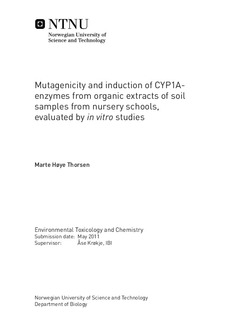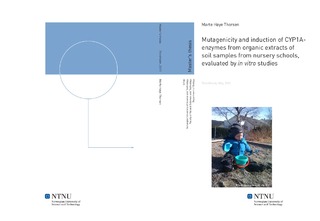| dc.description.abstract | Polluted soil can be a problem in urban areas, and can have a direct impact on human health upon exposure. The toxic potential of mixtures can be mediated by constituents and information about toxicity of mixtures is regarded as important, as it represents the real exposure situation. The main purpose of this project was to measure the mutagenic and CYP1A inducing potential in vitro from organic extracts of soil, sampled in nursery schools in Oslo. Selection of soil was mainly based on the content of ∑PAH16 and ∑PCB7, chemical groups known to include CYP1A inducing and/or genotoxic and mutagenic compounds. Generally were Soil 1 considered as a clean sample, Soil 2 to Soil 4 contained increasing level of PAHs and Soil 5 contained mainly elevated levels of PCBs. Assessing varying samples in relation to chemical content was valuable due to potential differences in biological responses. The soil samples were of top soil (0- 2 cm depth) and had been collected by NGU in connection to a geological survey of soil at playgrounds in nursery schools and schools in Norway. The soil was sampled in 2005- 2007, dried at 40 °C for one to two weeks, sieved in a 2 mm nylon sieve and stored in the dark at room temperature. Chemical analyses of both inorganic and organic compounds were performed before storage. In relation to this master project the organic pollutants in the selected soil samples were extracted by ultrasonic agitation in dichloromethane (DCM). Before experimental use the solvent was changed into dichloromethane (DMSO) by evaporating off the DCM using a water bath at 25 °C and a flow of nitrogen above. The dried extracts were redissolved in DMSO.The Ames Salmonella typhimurium assay was used for measuring mutagenicity. The presence of primary and secondary mutagens was assessed by conducting the assay both with and without addition of a metabolic S9- mix. Induction of different point mutations was revealed by utilising two bacterial strains, TA98 and TA100, detecting frameshift and base- pair substitutions, respectively. Induction of CYP1A enzymes was assessed in the rat H4IIE hepatoma cell line, and measured immunologically by Western blotting. The exposure concentrations used in the CYP1A assay were based on results of cell viability, assessed by utilising MTT- assay for finding the highest non- cytotoxic exposure concentrations. Concentration ranges of the extracts were tested in both assays. The mutagenic potential of extracts showed presence of secondary mutagenic compounds, and indicated absence or very low levels of primary mutagens. It was a general incidence of higher mutagenic activity with TA98 than TA100, reflecting highest induction of frameshift mutations. The inducing potential of extracts was in accordance with chemical analysis, showing a general increase in the potential of extract from Soil 1 to Soil 4, suggested to partly reflect differences in level of PAHs. The relative low potency of extract from Soil 5 was considered to be a reflection of a low content of PAHs and an expected dominance of PCBs, which have shown not to induce mutagens in the Ames assay.Induction of CYP1A in H4IIE was measured after exposure to extracts of Soil 3, Soil 4 and Soil 5. Results clearly indicated presence of CYP1A inducers in the extracts. A positive concentration- effect relationship was detected from exposure to extract of Soil 5. Extract of Soil 3 and Soil 4 did clearly induce CYP1A, but in a negative concentration dependent manner. These negative responses were suggested to indicate inhibition of CYP1A induction at the higher concentration, which may be linked to antagonism at the Ah- receptor. The biological endpoints measured in the current project reflected the integrated effect from extract exposure, potentially affected by additivity, synergism and/or antagonism. Differences in toxicity between in vitro and in vivo conditions, along with several biological and environmental parameters can affect the biological responses. The results obtained in the current project indicated presence of potential hazards in the soil, but no further conclusion could be drawn about the actual hazard from humans exposure to polluted soil. | nb_NO |

